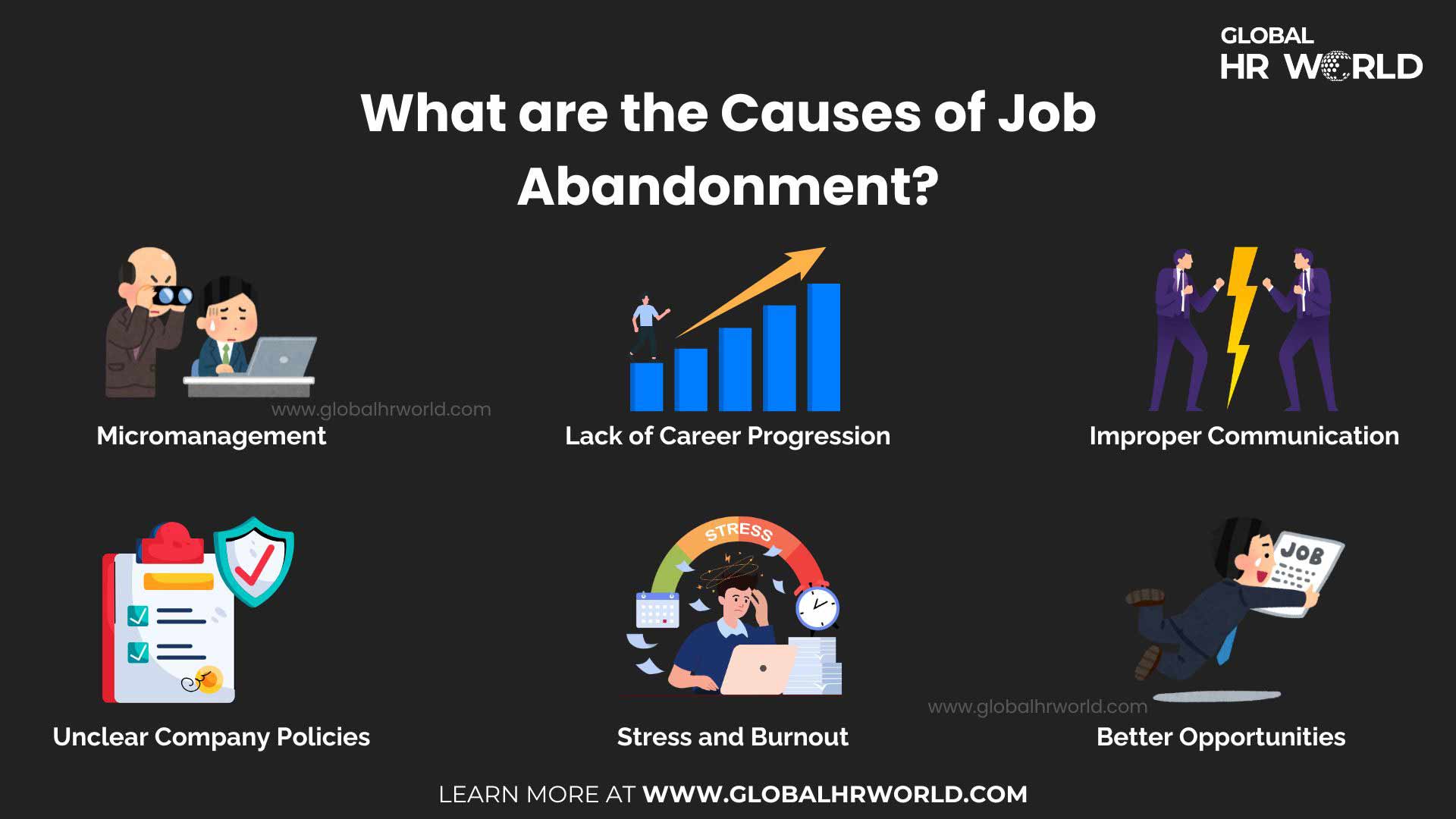Job abandonment is a significant concern for organizations, as it can disrupt operations and raise unexpected challenges. To maintain a positive and productive workplace, employers need to understand what job abandonment is, examine its causes and consequences, and implement effective strategies to prevent it.
What is Job Abandonment?
Job abandonment refers to a situation where an employee fails to report to work for several consecutive days without prior notice to the employer, creating uncertainty and disruption within the organization. It differs from absenteeism, which typically involves repeated or prolonged absences that are either pre-approved or accompanied by some form of communication, such as notice or explanation. Although policies concerning job abandonment may vary among organizations, there are certain benchmarks to determine whether it constitutes job abandonment and whether it should be considered voluntary resignation.
- Employee undertakes leave without any communication for three days. Some companies extend it to even 5 days.
- Employee fails to respond to all sorts of communication from the workplace within 72 hours of contact.
- Employee does not return to work after approved leave and does not communicate the same.
- Removing personal belongings from the workplace alongside stopping reporting to work.
- Employers must establish clear laws that would prevent this situation from arising, as it disrupts the overall organizational operations.
What are the Causes of Job Abandonment?

People often question the reason why employees abandon their jobs without any prior notice. While it may seem abrupt, job abandonment can stem from various underlying issues in the workplace. Organizations with a supportive environment, clear policies, and strong communication are less likely to face such situations. However, in many cases, certain conditions can drive employees to leave without explanation. Here are some of the most common causes of job abandonment:
Micromanagement
Micromanagement is a management style that involves an excessive level of scrutiny or supervision of employees. Micromanagement can make employees feel uncomfortable and overwhelmed due to excessive oversight and pressure. When workers feel their autonomy is constantly undermined, it can create a stressful environment and eventually result in job abandonment. According to the Workplace Red Flags Poll by Monster, “73% of workers consider micromanagement the biggest workplace ‘red flag’ and 46% identify it as a reason they would leave their job.”
Lack of Career Progression
Lack of career progression is a common reason employees choose to abandon their jobs. Many professionals seek out organizations that invest in their growth through training, mentorship, or development initiatives. When these opportunities are absent, employees may feel undervalued and disengaged. Over time, this lack of motivation and sense of stagnation can lead to a decline in commitment and ultimately result in job abandonment.
Improper Communication
When employees are not informed about company policies, organizational changes, or their roles and responsibilities, it creates confusion and frustration. Poor communication can erode trust, spark misunderstandings, conflicts, and contribute to a disengaged workforce. In such an environment, employees may begin to feel that their presence or absence goes unnoticed, which can ultimately lead them to leave the organization without giving formal notice.
Unclear Company Policies
Unclear or poorly communicated leave policies can contribute to job abandonment. When employers fail to establish clear guidelines around leave entitlements or neglect to communicate them during onboarding or in written policies, employees may feel uncertain about how to request time off or what is considered acceptable. This lack of clarity can lead to employees choosing to stop showing up altogether without formally resigning.
Stress and Burnout
Stress and burnout are major contributors to job abandonment. Employees who face ongoing conflicts, excessive workloads, or a lack of work-life balance may have a worse impact on their mental and emotional well-being. Over time, this chronic stress can lead to burnout, leaving individuals abandoning their jobs without notice as a means of escape from the pressure and to protect their mental health.
Better Opportunities
When employees are offered better job opportunities, such as higher pay, better benefits, or greater career progression, they are inclined to leave their current position, particularly if their current employer offers limited growth potential or poor communication. Moreover, if the organization has a lengthy notice period, like three months could create additional pressure to leave without fulfilling the formal exit process, leading to job abandonment.
What are the Consequences of Job Abandonment?
Job abandonment has significant consequences for organizations, particularly in terms of workflow and productivity. Here are some of the consequences of job abandonment.
Workflow Disruptions
One major consequence of job abandonment is the disruption of workflow across teams. Workloads are typically distributed based on team capacity; therefore, when an employee suddenly leaves without notice, it creates a significant imbalance. The remaining team members are often forced to absorb the extra responsibilities, leading to increased stress, reduced efficiency, and potential burnout. Furthermore, this sudden shift can also create confusion and congestion in task delegation, slowing down progress and impacting overall performance.
Immediate Hiring Costs
When employees abandon their jobs without prior notice, it creates unexpected costs for the organization. Employers are forced to invest time and resources into the rehiring process, including job advertisements, recruitment marketing, interviews, onboarding, and training.
Reputational Damage
Job abandonment can lead to negative perceptions among potential candidates, clients, and even current employees, making the organization appear unstable or unattractive as a place to work.
Pressure on HR
Job abandonment places additional pressure on the Human Resources (HR) team as the department is responsible for workforce planning, recruitment, and policy management. When an employee leaves without notice, HR must quickly adjust staffing plans, initiate urgent hiring processes, and sometimes revise workplace policies to prevent future incidents.
Staff Distrust
When employees leave suddenly without notice, it can create scepticism among those who remain. Existing employees may begin to question the organization’s management practices, culture, or stability, lowering morale, eroding trust, and increasing the risk of further turnover.
Retention Strategies to Prevent Job Abandonment
Understanding the consequences of job abandonment, organizations can implement the following strategies to help prevent it:
- Establish clear, written policies and communicate them effectively for easy reference at any time.
- Provide ongoing training and clear opportunities for career growth.
- Foster open communication and use reliable channels to keep employees informed about organizational updates.
- Monitor for signs of disengagement or other red flags and address issues promptly.
- Promote a supportive work culture by helping at all levels, providing mentorship opportunities, and encouraging collaboration.
- Provide regular feedback and support, track performance, and offer actionable improvement plans.
- Offer wellness initiatives such as mental health support, financial wellness programs, and other employee benefits to promote overall well-being.
- Recognize and reward top performers to motivate them and boost overall job satisfaction.
Conclusion
In short, job abandonment is a serious issue where employees leave without notice, disrupting business operations. Common causes include micromanagement, lack of career progression, poor communication, workplace stress, and more attractive opportunities elsewhere. The consequences can be severe ranging from workflow disruptions and increased hiring costs to reputational damage and added pressure on HR and staff. Organizations must adopt preventive measures like clear policies, career development, open communication, and wellness initiatives to retaining top talent and minimizing abandonment.
Infographic

Knowledge Check!
Frequently Asked Questions (FAQs)
What is job abandonment?
Job abandonment refers to a situation where an employee fails to report to work for several consecutive days without prior notice to the employer, creating uncertainty and disruption within the organization.
How is job abandonment different from absenteeism?
Job abandonment differs from absenteeism, which typically involves repeated or prolonged absences that are either pre-approved or accompanied by some form of communication, such as notice or explanation.
What are the causes of job abandonment?
Common causes include micromanagement, lack of career progression, poor communication, workplace stress, and more attractive opportunities elsewhere.
What are the consequences of job abandonment?
The consequences can be severe ranging from workflow disruptions and increased hiring costs to reputational damage and added pressure on HR and staff.



